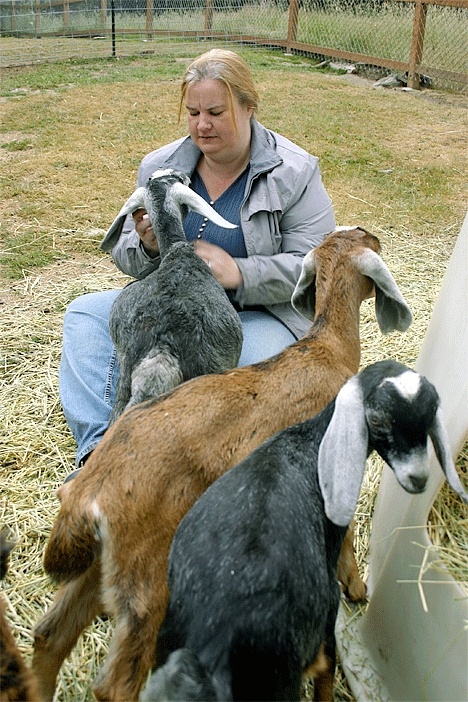A lost industry that was once a hallmark of Whidbey Island life is poised to make a return, albeit on a smaller scale.
Freeland resident Vicky Brown is hoping to have her creamery operational by August. The dairy, known as The Little Brown Farm, will sell goat and sheep cheese.
She is raising approximately 30 American Nubian goats and East Friesian Sheep on her modest five-acre farm located in the woods south of Freeland. Located on a slope, she chose the farm because the barn built on the property provided the perfect spot for her equipment.
It was feeding time for the Nubians during a recent visit. When not eating, some would stand on their hind legs in an attempt to nibble tree branches hanging overhead. Brown kept the males, females and recently weaned kids in separate pens.
She hopes to use the milk those animals produce in her cheesemaking operation.
“I have control over the product from the very beginning,” Brown said, emphasizing that quality is job one.
In addition to raising her animals, she and her husband are also busy installing the dairy equipment needed to produce her cheese. She purchased the equipment from a Colorado diary that went out of business last year.
She will begin with two kinds of cheese. She hopes to produce different flavors of feta and chevre cheeses from the milk her goats and sheep produce. The Little Brown Farm will be a visitor-friendly place with a large window in the barn that people can peer through to see the cheese- making process first hand.
Brown has spent the past three years navigating bureaucracy at the county and state levels to get her farm off the ground. Organizations such as WSU Extension and the Northwest Agriculture Business Center helped with her planning.
She complimented the support the Whidbey Island Conservation District provided as well. That agency helped her determine the animal load that is suitable for her property, and advised on developing a wildlife corridor and wetland protection plan.
“We’ve helped link her to the resources she needed to get going,” said Karen Bishop, Conservation District manager. She noted the Conservation District also helped Brown develop a nutrient management plan, which is a requirement needed for county and state permits. That plan outlines how much manure is produced and how it’s disposed of. The plan also outlines the way a nutrition balance is maintained on the land.
Bishop was a good resource for the dairy project. She formerly helped run the last cow dairy on Whidbey Island, Sherman Bishop Farms, which stopped operating two years ago. Dairying was one a mainstay of island agriculture. As late as the 1990s there were 11 dairies operating throughout Whidbey Island, however, they all eventually closed down due to competition from larger farms or other reasons.
“I’m really excited we will have a producer and processor,” Bishop said, adding the land on Whidbey Island is very conducive for growing feed for dairy farms.
Brown hopes to have product ready in time for the Lavender Wind Arts Festival that starts August 8 at Lavender Wind Farm located near West Beach Road on North Whidbey.
Brown’s wants to sell her cheese at the Bayview, and, hopefully, Coupeville farmers markets, as well as several island retail outlets, including Chef’s Pantry, Bayleaf and the Wine Shop.
In addition, Brown plans to offer classes to encourage other people to open dairies and help bring the dairy business back to Whidbey Island a few goats and sheep at a time.



